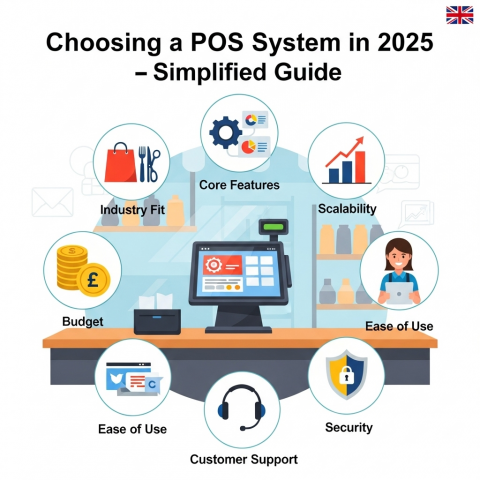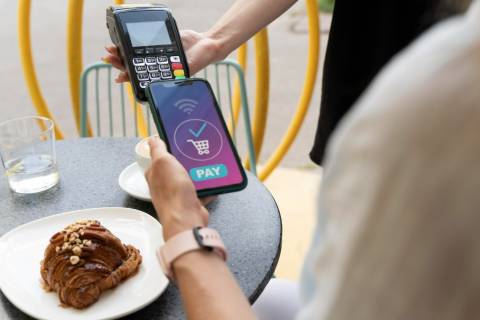Whether you run a small shop, a restaurant, or a multi-location business, it’s important to know: Can my website support a POS system? Can I integrate WooCommerce or Shopify with my POS? Which POS works best in the UK? This guide answers all of that.
Choosing the a new POS system is a strategic decision that affects efficiency, customer experience, and long-term growth.
We have compared these 5 POS systems for your UK business, and in this post, we will talk in detail on how to choose between them :

The Evolving Landscape of POS in 2025: Beyond Transactions
Gone are the days when a POS simply processed payments. Today’s systems are integrated platforms that manage everything from inventory and staff to customer relationships and online sales channels. The macro context of choosing a POS in 2025 involves recognizing its role as a unified business management solution. Key trends influencing this choice include:
- Cloud-Based Dominance: Access your POS anywhere, get real-time sales reporting, and reduce costs.
- Cloud-based POS systems are now standard in 2025. They let business owners check sales and stock from anywhere—at the store, at home, or on the go. The system updates automatically, keeping data safe and up-to-date without extra work or costs.
- Integrated Ecosystems: Works with accounting software (Xero, QuickBooks UK), CRM, e-commerce platforms, and marketing tools.
- Your POS should connect with your accounting software, CRM, online store, e-commerce platforms, and marketing tools. A good POS in 2025 shares data automatically and keeps everything in sync, saving you time and avoiding mistakes
- Mobile & Contactless Payments: Accept Apple Pay, Google Pay, QR codes, and tap-to-pay for convenience and hygiene.

- Customers want fast, easy, and safe ways to pay. Modern POS systems should work with many payment types, like mobile wallets, QR codes, tap-to-pay, or regular credit/debit cards, so every customer can pay their way.
- Data Analytics & AI: Predict trends, optimize inventory, and track customer behaviour for smarter decisions.
- Good POS systems in 2025 have built-in dashboards and smart tools that show what sells best, predict how many staff you need, and suggest deals or promotions. This helps shops make better decisions using real data instead of guessing
- Customer Experience Focus: Use loyalty programs, personalized offers, and fast checkout to improve service.
- A POS does more than process payments. It helps you give customers personalized offers, run loyalty programs, speed up checkouts, and even manage self-service kiosks. By tracking customer behavior, including interactions on social media, you can make smarter decisions and build stronger, more profitable relationships
In short, choosing a POS in 2025 means choosing a business partner, not just a payment processor. The right system will not only handle today’s operational needs but also provide the flexibility, intelligence, and scalability to adapt to tomorrow’s challenges.
Key Factors to Consider When Choosing Your POS System
To narrow down the vast array of options, it’s crucial to evaluate potential POS systems against a set of core criteria tailored to your business’s unique micro context. Each of these factors represents a critical entity in your selection process.
-
Key Considerations When Choosing a POS System in the UK
| Factor | Key Question | Why It Matters | Examples & Tips |
| Industry Fit & Specialisation | Is the POS designed for your industry (retail, hospitality, services, etc.)? | Industry-specific POS systems include tailored tools that streamline workflows, avoiding costly workarounds. | Restaurants need table management, KDS, split billing; retail needs barcode scanning, inventory sync; salons need appointment booking & client profiles. Look for providers with experience in your niche. |
| Core Features & Functionality | Does it have all essential features, plus room to expand? | Beyond sales processing, essential features boost efficiency and insights. | Inventory tracking, payment options (cards, NFC, wallets), reporting/analytics, CRM, employee management, integrations (accounting, e-commerce), and online ordering/booking. |
| Scalability & Future-Proofing | Can it grow with your business? | A scalable POS avoids costly migrations as you expand. | Cloud-based systems allow adding locations, users, and features without a full overhaul. |
| Budget: Cost vs. Value | What’s the total cost, and is it worth it? | A cheap system can become costly if it lacks features or has high fees. | Consider hardware, software subscriptions, payment fees, setup/training, and hidden costs (contracts, integration charges). Ask for a full cost breakdown. |
| Ease of Use & Training | Is it intuitive for you and your staff? | A simple interface reduces errors, speeds service, and shortens training time. | Test demos/trials; staff should adapt quickly with minimal guidance. |
| Customer Support & Reliability | What support is available if issues occur? | Downtime during busy hours can cost sales. | Look for 24/7 support via phone, chat, or email; check uptime history and redundancy measures. |
| Security & Compliance | Does it protect data and meet regulations? | Security breaches damage trust and risk fines. | Must be PCI DSS compliant, GDPR-compliant, offer encryption, tokenisation, and audit trails to prevent fraud. |
Choosing the ideal POS system in 2025 isn’t just about a register. You need one that tracks sales, manages inventory, connects with your online shop, and helps your business grow. For restaurants, a good restaurant management systemis essential, while retail needs features like mobile POS devices and integration with payment gateways.
Top POS UK options include Lightspeed, EposNow, SquarePOS, SumUp and ZettlePOS .When evaluating, consider cost, UK accounting integration, technical support, PCI DSS and GDPR compliance, contactless payments, and reporting. The right POS keeps your business running smoothly and ready for digital growth.”
The Decision-Making Process: Your Strategic Steps
- Assess Your Needs: Clearly define your current operational requirements and future growth plans. What are your must-have features? What are your nice-to-haves?
- Research & Shortlist: Identify 3-5 POS systems that seem to fit your industry and core needs. Utilize online reviews, industry reports, and competitor analysis.
- Request Demos & Trials: Don’t just read about them; experience them. Request personalized demos and, if possible, sign up for free trials to test the system in a real-world scenario, Square pos and lightspeed offer demos directly on their websites.
- Get Quotes: Obtain detailed, transparent quotes from your shortlisted providers, ensuring all costs (hardware, software, processing, support) are included, EposNow, has a simple form, to get an instant quote.
- Check References: If possible, speak to other businesses in your industry who use the system. Their real-world experience can provide invaluable insights.
- Consider Implementation & Training: Understand the implementation process. Will the provider assist with data migration and staff training?
- Make Your Choice: Based on a holistic evaluation of features, cost, usability, support, and scalability, select the POS system that offers the best long-term value for your business.
POS Systems in the UK: What Buyers Should Know in 2025 ?
The UK EPOS market is thriving, and leading providers like : Lightspeed, EposNow, SquarePOS, SumUp and ZettlePOS are setting the standard for performance, integration, and value.
When looking for the best POS system UK 2025, it’s essential to go beyond basic payment processing. Businesses should consider factors such as UK-based customer support, integration with HMRC-compliant accounting software, and compatibility with popular local payment methods.
Whether you run a retail store, restaurant, salon, or mobile business, choosing a system that works seamlessly with your workflow will save time and boost profitability.
Choosing the Best POS for Small Businesses UK
For small and growing businesses, flexibility and scalability are key. POS software like SumUp and Zettle POS is popular among UK micro-businesses because of quick setup, low monthly fees, and easy use with card readers.
For larger operations, point of sale systems like Lightspeed and Epos Now offer management systems for multi-location stores and restaurants.
Square POS stands out for its all-in-one hardware and software, transparent transaction fees, and support for contactless payments, Apple Pay, Google Pay, and major UK debit cards. Many of these systems include online ordering, sales reporting, and tools to manage customer data and customer information.
Investing in the right POS system today ensures you won’t have to switch providers as your business grows. Look for key features like inventory tracking, payment gateways, integration with accounting software, and connections to social media or e-commerce platforms. A wide range of payment options helps meet customer expectations and protects your bottom line.
A Strategic Investment for 2025 and Beyond
A modern point of sale system is more than a register. It’s a central hub for sales, inventory, customer engagement, and business intelligence. Your POS software should keep up as your business grows. It should track customer data, accept different payment methods, and work smoothly with your website, online orders, and marketing tools..
Scalability is critical: your POS should grow with your business, handle new sales channels, and manage more customer information without slowing down or requiring expensive upgrades. Understanding all costs, from monthly fees and hardware and software to transaction fees and support, lets you budget effectively.
By choosing a POS system that balances usability, key features, and future readiness, you streamline daily tasks, get clear sales reporting, and can adapt to market changes. A smart investment today protects your bottom line and ensures your system continues to support your business’s growth for years to come.







